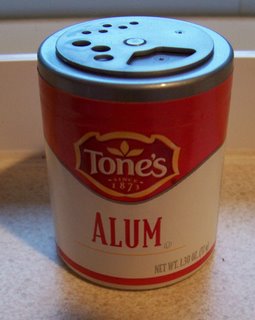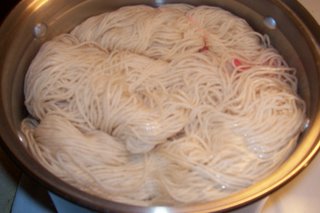Tuesday, July 04, 2006
The Adventure Continues
Okay, so Blogger doesn't want more than 5 images per post today. Okay. We can live with this.
We'll just split this into 2 posts. Or episodes. Or whatever.

Let's see. What came next? Oh yeh, soaking the yarn. Conventional wisdom says that wet yarn will accept the dye better. And besides, new cotton is notoriously water repellant. So I soaked the skeined stuff overnight.
I use my salad spinner for this since it has a built-in drainer.

Natural dyes require a mordant to help set the dye and to do other stuff.
I had a choice here (depending on which web site I followed) of alum or vinegar.
Since I had already purchased the alum, I decided that I would give it first crack.
Alum is available in the grocery store, near the spices. This container was $1.39. McCorick makes it too. It's more expensive.

I put about 2 gallons of cold water and that little container of alum into a stainless steel soup pot, added the yarn and brought the whole thing to a boil. Then I lowered the heat and simmered for an hour.
Please note that I really am using pots and other kitchen equipment that I use for cooking. I am neither brave, nor stupid. All of the "ingredients" are food. Sassafras is brewed for tea. Alum is an ingredient in pickles. Food quality stuff.
(And I am thoroughly, completely cleaning up as I go.)

While the yarn was simmering, I removed most of the leaves from the dyebath and brought the dyestuff back up to hot.
There are no more pictures for the moment. I've layered the leaves and extracted dye with my skeined up yarn. I'm going for a mottled kettle-dyed look here, so I'm hoping that the remaining color in the leaves will stain parts of the yarn a darker color.

In about 4-6 hours, I'll check the color and either drain and rinse (and hang to dry) or leave it in the pot a little longer.
The good news is that this stuff actually smells quite pleasant simmering. The bad news is that it's increasing both the temperature and the humidity in the kitchen.
Such is life.
We'll just split this into 2 posts. Or episodes. Or whatever.

Let's see. What came next? Oh yeh, soaking the yarn. Conventional wisdom says that wet yarn will accept the dye better. And besides, new cotton is notoriously water repellant. So I soaked the skeined stuff overnight.
I use my salad spinner for this since it has a built-in drainer.

Natural dyes require a mordant to help set the dye and to do other stuff.
I had a choice here (depending on which web site I followed) of alum or vinegar.
Since I had already purchased the alum, I decided that I would give it first crack.
Alum is available in the grocery store, near the spices. This container was $1.39. McCorick makes it too. It's more expensive.

I put about 2 gallons of cold water and that little container of alum into a stainless steel soup pot, added the yarn and brought the whole thing to a boil. Then I lowered the heat and simmered for an hour.
Please note that I really am using pots and other kitchen equipment that I use for cooking. I am neither brave, nor stupid. All of the "ingredients" are food. Sassafras is brewed for tea. Alum is an ingredient in pickles. Food quality stuff.
(And I am thoroughly, completely cleaning up as I go.)

While the yarn was simmering, I removed most of the leaves from the dyebath and brought the dyestuff back up to hot.
There are no more pictures for the moment. I've layered the leaves and extracted dye with my skeined up yarn. I'm going for a mottled kettle-dyed look here, so I'm hoping that the remaining color in the leaves will stain parts of the yarn a darker color.

In about 4-6 hours, I'll check the color and either drain and rinse (and hang to dry) or leave it in the pot a little longer.
The good news is that this stuff actually smells quite pleasant simmering. The bad news is that it's increasing both the temperature and the humidity in the kitchen.
Such is life.
Comments:
<< Home
I'm impressed! I still haven't gotten up the nerve to dye with Kool-Aid. I'm such a chicken-s***.
Happy Fourth of July!
Happy Fourth of July!
Sassyfras tea is considered a spring tonic in Appalachia; very delicious!
Thanks for the pleasure of reading along with your dye project.
Would you, please, consider publishing this on www.fiberfemmes.com ? Thanks,
Sandra
Post a Comment
Thanks for the pleasure of reading along with your dye project.
Would you, please, consider publishing this on www.fiberfemmes.com ? Thanks,
Sandra
<< Home




![[HeettheFeet20083.jpg]](https://blogger.googleusercontent.com/img/b/R29vZ2xl/AVvXsEiCRH_T42wVcDuEXnRRcJTi8Xx0pZMjwaEvKKUYxkKGb3RbfVJvbBKJaplnruL4Y1lQGy9LWjb2KhOsPi10kdPRppP6_O47YprEco3m4iD3JMmT1o-7Hc6zuCWJT-0gxesUCp_H/s1600/HeettheFeet20083.jpg)
![[mittnz2008buttin.jpg]](https://blogger.googleusercontent.com/img/b/R29vZ2xl/AVvXsEjhkbBquqYIEHAWQxsnQtaptULuJ-jj-mlpdjbffH9r1n1liR1r8yRRkXMgJLBxbeo0x3w2wU_gLhjFzrxzKrMmVgUGSqAzkP89jlWOA04Xhr2pWmVGIDgt8VGWAK-FZMfwB6j6/s1600/mittnz2008buttin.jpg)
![[heet2009-1.jpg]](https://blogger.googleusercontent.com/img/b/R29vZ2xl/AVvXsEi4SiW5ds26X6RV2guuohZ5nCdtljV9Pj8cVQCebCBg8EYaQR_DXHlIgLihx-5ddowYTS8hM11_JCwqlbN0qLGhUHjIsea9xw5v9tu4Cdnn0dHCRU5NXLAN-VH_o7jT1WW3w74R_w/s320/heet2009-1.jpg)
![[mittnz 2009 button.jpg]](https://blogger.googleusercontent.com/img/b/R29vZ2xl/AVvXsEjpuGtaAayAUpfk3b8FnVyyIvB5jI1YxPMmcN2M9PyQo9MfDK9JVxgFz2z7rLFuGjebz7CBV-frRyUYMXFzFLmwtP_xmCwd9HEgKylZaZwzwfSV8xTZ5a6vayaG0oEbFxgjYFTa5w/s320/mittnz+2009+button.jpg)